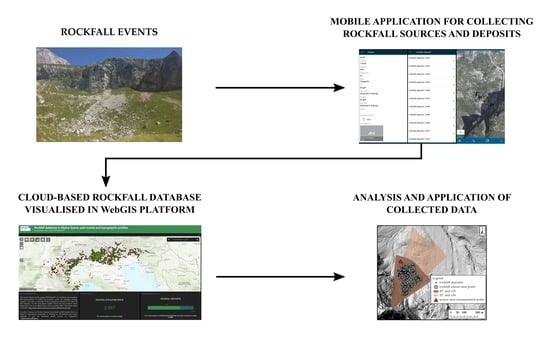A New Methodology for Mapping Past Rockfall Events: From Mobile Crowdsourcing to Rockfall Simulation Validation
Abstract
:1. Introduction
- (1)
- (2)
- (3)
- (4)
- (5)
2. Materials and Methods
2.1. Field Work
2.1.1. Characterisation of the Mobile Application
2.1.2. Collection of Data in the Field
2.1.3. Data Attributes
2.2. Data Processing
2.2.1. Synchronisation of Data and Visualisation in the WebGIS Platform
2.2.2. Calculation of an Actual Rockfall Source Area and Energy Line Angles
3. Results
3.1. Case Study: Rockfall Database in the Alpine Space
3.2. Application of Collected Data for Calibration and Validation of Rockfall Modelling
3.2.1. Krnica Rockfall
3.2.2. Trenta Rockfall
4. Discussion
- Level 1 user: can access the WebGIS platform only for visualisation of the collected data.
- Level 2 user: can access the WebGIS platform for visualisation and can use the mobile application for collection of data and for updating the data on the WebGIS platform.
- Level 3 user: has the same abilities as the Level 2 user, and can additionally operate with the geodatabase by updating it with external data, can control the WebGIS and mobile application, and perform complex queries and analyses on data in the geodatabase.
5. Conclusions
Author Contributions
Funding
Acknowledgments
Conflicts of Interest
References
- Cruden, D.M.; Varnes, D.J. Landslide types and processes. In Landslides Investigation and Mitigation; National Research Council, Transportation Research Board; Special Report 247; Turner, A.K., Schuster, R.L., Eds.; Transportation Research Board: Washington, DC, USA, 1996; pp. 36–75. [Google Scholar]
- Lopez-Saez, J.; Corona, C.; Eckert, N.; Stoffel, M.; Bourrier, F.; Berger, F. Impacts of land-use and land-cover changes on rockfall propagation: Insights from the Grenoble conurbation. Sci. Total Environ. 2016, 547, 345–355. [Google Scholar] [CrossRef] [PubMed]
- Corominas, J.; Mavrouli, O.; Ruiz-Carulla, R. Rockfall Occurrence and Fragmentation. In Advancing of Living with Landslides, WLF 2017; Sassa, K., Mikoš, M., Yin, Y., Eds.; Springer: Cham, Switzerland, 2017; pp. 75–97. [Google Scholar]
- Dorren, L.; Berger, F.; Jonsson, M.; Krautblatter, M.; Mölk, M.; Stoffel, M.; Wehrli, A. State of the art in rockfall—Forest interactions. Schweiz. Z. Forstwes 2007, 158, 128–141. [Google Scholar] [CrossRef] [Green Version]
- Volkwein, A.; Schellenberg, K.; Labiouse, V.; Agliardi, F.; Berger, F.; Bourrier, F.; Dorren, L.K.A.; Gerber, W.; Jaboyedoff, M. Rockfall characterization and structural protection—A review. Nat. Hazards Earth Syst. Sci. 2011, 11, 2617–2651. [Google Scholar] [CrossRef] [Green Version]
- Crosta, G.B.; Agliardi, F.; Frattini, P.; Lari, S. Key Issues in Rock Fall Modelling, Hazard and Risk Assessment for Rockfall Protection. In Engineering Geology for Society and Territory; Lollino, G., Giordan, D., Crosta, G.B., Corominas, J., Azzam, R., Wasowski, J., Sciarra, N., Eds.; Springer: Cham, Switzerland, 2015; Volume 3, pp. 43–58. [Google Scholar]
- Dussauge-Peisser, C.; Helmstetter, A.; Grasso, J.-R.; Hantz, D.; Desvarreux, P.; Jeannin, M.; Giraud, A. Probabilistic approach to rock fall hazard assessment: Potential of historical data analysis. Nat. Hazards Earth Syst. Sci. 2002, 2, 15–26. [Google Scholar] [CrossRef]
- Guzzetti, F.; Reichenbach, P.; Wieczorek, G.F. Rockfall hazard and risk assessment in the Yosemite Valley, California, USA. Nat. Hazards Earth Syst. Sci. 2003, 3, 491–503. [Google Scholar] [CrossRef] [Green Version]
- Malamud, B.D.; Turcotte, D.L.; Guzzetti, F.; Reichenbach, P. Landslide inventories and their statistical properties. Earth Surf. Process. Landf. 2004, 29, 687–711. [Google Scholar] [CrossRef]
- Mateos, R.M.; García-Moreno, I.; Reichenbach, P.; Herrera, G.; Sarro, R.; Rius, J.; Aguiló, R.; Fiorucci, F. Calibration and validation of rockfall modelling at regional scale: Application along a roadway in Mallorca (Spain) and organization of its management. Landslides 2016, 13, 751–763. [Google Scholar] [CrossRef]
- Žabota, B.; Repe, B.; Kobal, M. Influence of digital elevation model resolution on rockfall modelling. Geomorphology 2019, 328, 183–195. [Google Scholar] [CrossRef]
- Abbruzzese, J.M.; Sauthier, C.; Labiouse, V. Considerations on Swiss methodologies for rock fall hazard mapping based on trajectory modelling. Nat. Hazards Earth Syst. Sci. 2009, 9, 1095–1109. [Google Scholar] [CrossRef] [Green Version]
- Lari, S.; Frattini, P.; Crosta, G.B. A probalistic approach for landslide hazard analysis. Eng. Geol. 2014, 182, 3–14. [Google Scholar] [CrossRef] [Green Version]
- Mikoš, M.; Petje, U.; Ribičič, M. Application of a Rockfall Simulation Program in an Alpine Valley in Slovenia. In Disaster Mitigation of Debris Flows, Slope Failures and Landslides; Lambrat, S., Nicot, F., Eds.; Universal Academy Press, Inc.: Tokyo, Japan, 2006; pp. 199–211. [Google Scholar]
- De Biagi, V.; Lia Napoli, M.; Barbero, M.; Peila, D. Estimation of the return period of rockfalls according to the block size. Nat. Hazards Earth Syst. Sci. 2016, 17, 103–113. [Google Scholar] [CrossRef] [Green Version]
- Dussauge, C.; Grasso, J.-R.; Helmstetter, A. Statistical analysis of rockfall volume distributions: Implications for rockfall dynamics. J. Geophys. Res. 2003, 108, 2286. [Google Scholar] [CrossRef] [Green Version]
- Brunetti, M.T.; Guzzetti, F.; Rossi, M. Probability distributions of landslide volumes. Nonlinear Process. Geophys. 2009, 16, 179–188. [Google Scholar] [CrossRef]
- Corominas, J.; Mavrouli, O.; Ruiz-Carulla, R. Magnitude and frequency relations: Are there geological constrains to the rockfall size? Landslides 2018, 15, 829–845. [Google Scholar] [CrossRef] [Green Version]
- Jaboyedoff, M.; Dudt, J.P.; Labiouse, V. An attempt to refine rockfall hazard zoning based on the kinetic energy, frequency and fragmentation degree. Nat. Hazards Earth Syst. Sci. 2005, 5, 621–632. [Google Scholar] [CrossRef]
- Hungr, O.; Evans, S.G.; Hazzard, J. Magnitude and frequency of rock falls and rock slides along the main transportation corridors of southwestern British Columbia. Can. Geotech. J. 1999, 36, 224–238. [Google Scholar] [CrossRef]
- Rak, G.; Zupančič, G.; Papež, J.; Kozelj, D. Production of hazard, vulnerability and risk maps in the event of avalanches and rockfalls for a section of the Bohinj railway line. UJMA 2012, 26, 130–137. [Google Scholar]
- Guzzetti, F.; Reichenbach, P.; Ghigi, S. Rockfall hazard and risk assessment along a transportation corridor in the Nera valley, central Italy. Environ. Manag. 2004, 34, 191–208. [Google Scholar] [CrossRef]
- Stoffel, M.; Bollschweiler, M.; Butler, D.R.; Luckman, B.H. Tree Rings and Natural Hazards: An Introduction. In Tree rings and Natural Hazards. Advances in Global Change Research; Stoffel, M., Bollschweiler, M., Butler, D., Luckman, B., Eds.; Springer: Dordrecht International Publishing: Berlin, Germany, 2010; Volume 41, pp. 3–23. [Google Scholar]
- Trappmann, D.; Corona, C.; Stoffel, M. Rolling stones and tree rings. Prog. Phys. Geogr. Earth Environ. 2013, 37, 701–716. [Google Scholar] [CrossRef]
- Corona, C.; Lopez-Saez, J.; Favillier, A.; Mainieri, R.; Eckert, N.; Trappmann, D.; Stoffel, M.; Bourrier, F.; Berger, F. Modeling rockfall frequency and bounce height from three-dimensional simulation process models and growth disturbances in submontane broadleaved trees. Geomorphology 2017, 281, 66–77. [Google Scholar] [CrossRef]
- Favillier, A.; Mainieri, R.; Lopez-Saez, J.; Berger, F.; Stoffel, M.; Corona, C. Dendrogemorphic assessment of rockfall recurrence intervals at Saint Paul de Varces, Western French Alps. Géomophologie Relief Process. Environ. 2017, 23. [Google Scholar] [CrossRef]
- Schober, A.; Bannwart, C.; Keuschnig, M. Rockfall modelling in high alpine terrain—Validation and limitations/Steinschlagsimulation in hochalpinem Raum—Validierung und Limitationen. Geomech. Tunn. 2012, 5, 368–378. [Google Scholar] [CrossRef]
- Gomez, C.; Purdie, H. UAV-based Photogrammetry and Geocomputing for Hazards and Disaster Risk Monitoring—A Review. Geoenvironmental Disasters 2016, 3, 1–11. [Google Scholar] [CrossRef] [Green Version]
- Sarro, R.; Riquelme, A.; García-Davalillo, J.C.; Mateos, R.M.; Tomás, R.; Pastor, J.L.; Cano, M.; Herrera, G. Rockfall simulation based on UAV photogrammetry data obtained during an emergency declaration: Application at a cultural heritage site. Remote Sens. 2018, 10, 1923. [Google Scholar] [CrossRef] [Green Version]
- Saroglou, C.; Asteriou, P.; Zekkos, D.; Tsiambaos, G.; Clark, M.; Manousakis, J. UAV-based mapping, back analysis and trajectory modeling of a coseismic rockfall in Lefkada island, Greece. Nat. Hazards Earth Syst. Sci. 2018, 18, 321–333. [Google Scholar] [CrossRef] [Green Version]
- Vanneschi, C.; Camillo, M.D.; Aiello, E.; Bonciani, F.; Salvini, R. SFM-MVS photogrammetry for rockfall analysis and hazard assessment along the ancient roman via Flaminia road at the Furlo gorge (Italy). ISPRS Int. J. Geo-Inf. 2019, 8, 325. [Google Scholar] [CrossRef] [Green Version]
- Corò, D.; Galgaro, A.; Fontana, A.; Carton, A. A regional rockfall database: The Eastern Alps test site. Environ. Earth Sci. 2015, 74, 1731–1742. [Google Scholar] [CrossRef]
- Ferrari, F.; Giacomini, A.; Thoeni, K. Qualitative Rockfall Hazard Assessment: A Comprehensive Review of Current Practices. Rock Mech. Rock Eng. 2016, 49, 2865–2922. [Google Scholar] [CrossRef]
- Rupp, S.; Damm, B. A national rockfall dataset as a tool for analyzing the spatial and temporal rockfall occurrence in Germany. Earth Surf. Process. Landf. 2020, 45, 1528–1538. [Google Scholar] [CrossRef]
- Ruiz-Carulla, R.; Corominas, J.; Mavrouli, O. A methodology to obtain the block size distribution of fragmental rockfall deposits. Landslides 2015, 12, 815–825. [Google Scholar] [CrossRef] [Green Version]
- Marchelli, M.; De Biagi, V. Optimization methods for the evaluation of the parameters of a rockfall fractal fragmentation model. Landslides 2019, 16, 1385–1396. [Google Scholar] [CrossRef]
- Budetta, P.; De Luca, C.; Nappi, M. Quantitative rockfall risk assessment for an important road by means of the rockfall risk management (RO.MA.) method. Bull. Eng. Geol. Environ. 2016, 75, 1377–1397. [Google Scholar] [CrossRef]
- Copons, R.; Vilaplana, J.M.; Linares, R. Rockfall travel distance analysis by using empirical models (Solà d’Andorra la Vella, Central Pyrenees). Nat. Hazards Earth Syst. Sci. 2009, 9, 2107–2118. [Google Scholar] [CrossRef] [Green Version]
- De Biagi, V. Brief communication: Accuracy of the fallen blocks volume-frequency law. Nat. Hazards Earth Syst. Sci. 2017, 17, 1487–1492. [Google Scholar] [CrossRef] [Green Version]
- Marchelli, M.; De Biagi, V.; Peila, D. Reliability-Based Design of Protection Net Fences: Influence of Rockfall Uncertainties through a Statistical Analysis. Geosciences 2020, 10, 280. [Google Scholar] [CrossRef]
- Zhu, Y.; Zhu, H.; Yu, J.; Cao, J.; Ni, L. Towards truthful mechanisms for mobile crowdsourcing with dynamic smartphones. In Proceedings of the 34th International Conference on Distributed Computer Systems, Madrid, Spain, 30 June–3 July 2014; pp. 11–20. [Google Scholar]
- Howe, J. The rise of crowdsourcing. Wired Mag. 2006, 14, 1–4. [Google Scholar]
- Meissen, U.; Fuchs-Kittowski, F. Crowdsourcing in Early Warning Systems. In Proceedings of the International Environmental Modelling and Software Society (iEMSs) 7th International Congress on Environmental Modelling and Software, San Diego, CA, USA, 15–19 June 2014; Volume 1, pp. 1–7. [Google Scholar]
- Bielski, C.; O’Brien, V.; Whitmore, C.; Ylinen, K.; Juga, I.; Nurmi, P.; Kilpinen, J.; Porras, I.; Sole, J.M.; Gamez, P.; et al. Coupling Early Warning Services, Crowdsourcing, and Modelling for Improved Decision Support and Wildfire Emergency Management. In Proceedings of the IEEE International Conference on Big Data (BIGDATA), Boston, MA, USA, 11–14 December 2017; pp. 217–230. [Google Scholar]
- See, L. A review of citizen science and crowdsourcing in applications of pluvial flooding. Front. Earth Sci. 2019, 7, 44. [Google Scholar] [CrossRef] [Green Version]
- Choi, C.C.; Cui, Y.; Zhou, G.G.D. Utilizing crowdsourcing to enhance the mitigation and management of landslides. Landslides 2018, 15, 1889–1899. [Google Scholar] [CrossRef]
- Olyazadeh, R.; Sudmeier-Rieux, K.; Jaboyedoff, M.; Derron, M.-H.; Devkota, S. An offline-online Web-GIS Android application for fast data acquisition of landslide hazard and risk. Nat. Hazards Earth Syst. Sci. 2017, 17, 549–561. [Google Scholar] [CrossRef] [Green Version]
- Kocaman, S.; Gokceoglu, C. A CitSci app for landslide data collection. Landslides 2019, 16, 611–615. [Google Scholar] [CrossRef]
- Juang, C.S.; Stanley, T.A.; Kirschbaum, D.B. Using citizen science to expand the global map of landslides: Introducing the cooperative open online landslide repository (COOLR). PLoS ONE 2019, 14, e0218657. [Google Scholar] [CrossRef] [PubMed] [Green Version]
- Chu, H.J.; Chen, Y.C. Crowdsourcing photograph locations for debris flow hot spot mapping. Nat. Hazards 2018, 90, 1259–1276. [Google Scholar] [CrossRef]
- Collector for ArcGIS, Esri. Available online: http://www.esri.com/products/collector-for-arcgis (accessed on 21 June 2020).
- Ancelin, P.; Barthelon, C.; Berger, F.; Cardew, M.; Chauvin, C.; Courbaud, B.; Descroix, L.; Dorren, L.; Fay, J.; Gaudry, P.; et al. Guide des Sylvicultures de Montagne Alpes du Nord. Françaises; Irstea: Publications Scientifiques et Tehniques; Gestion des territoires—CemOA: Paris, France, 2006; p. 289. [Google Scholar]
- ArcGIS for Desktop, Esri. Available online: http://desktop.arcgis.com/en/ (accessed on 23 July 2020).
- Heim, A. Bergsturz und Menschenleben. Beibl. Vierteljahrsschr. Nat. Ges. Zürich 1932, 20, 218. [Google Scholar]
- Jaboyedoff, M.; Labiouse, V. Technical Note: Preliminary estimation of rockfall runout zones. Nat. Hazards Earth Syst. Sci. 2011, 11, 819–828. [Google Scholar] [CrossRef] [Green Version]
- RockTheAlps—Alpine Forests Are Rock Stars! Interreg Alpine Space. Available online: https://www.alpine-space.eu/projects/rockthealps/en/home (accessed on 23 July 2020).
- University Grenoble Alpes—Zoning of Plant Life in the Mountains. 2018. Available online: https://www.jardinalpindulautaret.fr/garden/exceptional-natural-environment/zoning-plant-life-mountains (accessed on 15 June 2018).
- EU-DEM v1.1—Copernicus. 2016. Available online: https://land.copernicus.eu/pan-european/satellite-derived-products/eu-dem/eu-dem-v1.1/view (accessed on 19 August 2019).
- Dorren, L.K.A. Rockyfor3D (v5.2) Revealed—Transparent Description of the Complete 3D Rockfall Model; EcorisQ Paper; EcorisQ-International Association: Geneva, Switzerland, 2016; p. 32. [Google Scholar]
- Formetta, G.; Capparelli, G.; Versace, P. Evaluating performance of simplified physically based models for shallow landslide susceptibility. Hydrol. Earth Syst. Sci. 2016, 20, 4585–4603. [Google Scholar] [CrossRef] [Green Version]
- Larcher, V.; Simoni, S.; Pasquazzo, R.; Strada, C.; Zampediro, G.; Berger, F. PARAmount: WP6 Guidelines, Rockfall and Forest Systems; PARAmount: Los Angeles, CA, USA, 2012; p. 84. [Google Scholar]
- SMARS; The Surveying and Mapping Authority of the Republic Slovenia. LiDAR Data in D96/TM Projection. 2014. Available online: http://gis.arso.gov.si/evode/profile.aspx?id=atlas_voda_Lidar@Arso (accessed on 19 August 2019).
- Basharat, M.; Rohn, J. Effects on travel distance of mass movements trigged by the 2005 Kashmir earthquake, in the Northeast Himalayas of Pakistan. Nat. Hazards 2015, 77, 273–292. [Google Scholar] [CrossRef]
- Saas, O.; Oberlechner, M. Is climate causing increased rockfall frequency in Austria. Nat. Hazards Earth Syst. Sci. 2012, 12, 3209–3216. [Google Scholar] [CrossRef]
- Delonca, A.; Gunzburger, Y.; Verdel, T. Statistical correlation between meteorological and rockfall databases. Nat. Hazards Earth Syst. Sci. 2014, 14, 1953–1964. [Google Scholar] [CrossRef] [Green Version]
- D’Amato, J.; Hantz, D.; Guerin, A.; Jaboyedoff, M.; Baillet, L.; Mariscal, A. Influence of meteorological factors on rockfall occurrence in a middle mountain limestone cliff. Nat. Hazards Earth Syst. Sci. 2016, 16, 719–735. [Google Scholar] [CrossRef] [Green Version]
- Paranunzio, R.; Laio, F.; Chiarle, M.; Nigrelli, G.; Guzzetti, F. Climate anomalies associated with the occurance of rockfalls at high-elevation in the Italian Alps. Nat. Hazards Earth Syst. Sci. 2016, 16, 2085–2106. [Google Scholar] [CrossRef] [Green Version]
- Pratt, C.; Macciotta, R.; Hendry, M. Quantitative relationship between weather seasonality and rock fall occurrences north Hope, BC, Canada. Bull. Eng. Geol. Environ. 2019, 78, 3239–3251. [Google Scholar] [CrossRef]
- Duarte Menéndez, R.; Marquínez, J. The influence of environmental and lithologic factors on rockfall at a regional scale: An evaluation using GIS. Geomorphology 2002, 43, 117–136. [Google Scholar] [CrossRef]
- Borella, J.; Quigley, M.; Krauss, Z.; Lincoln, K.; Attanayake, J.; Stamp, L.; Lanman, H.; Levine, S.; Hampton, S.; Gravley, D. Geologic and geomorphic controls on rockfall hazard: How well do past rockfalls predict future distributions? Nat. Hazards Earth Syst. Sci. 2019, 19, 2249–2280. [Google Scholar] [CrossRef] [Green Version]
- Saroglou, C. GIS-Based Rockfall Susceptibility Zoning in Greece. Geosciences 2019, 9, 163. [Google Scholar] [CrossRef] [Green Version]
- Berger, F.; Dorren, L.; Kleemayr, K.; Maier, B.; Planinsek, S.; Bigot, C.; Bourrier, F.; Jancke, O.; Toe, D.; Cerbu, G. Eco-Engineering and Protection Forest Against Rockfalls and Snow Avalanches; Cerbu, G., Ed.; InTech: London, UK, 2013; pp. 191–210. [Google Scholar]
- Dupire, S.; Bourrier, F.; Monnet, J.-M.; Bigot, S.; Borginet, L.; Berger, F.; Curt, T. Novel quantitative indicators to characterize the protective effect of mountain forests against rockfall. Ecol. Indic. 2016, 67, 98–107. [Google Scholar] [CrossRef] [Green Version]
- Moos, C.; Dorren, L.; Stoffel, M. Quantifying the effect of forests on frequency and intensity of rockfalls. Nat. Hazards Earth Syst. Sci. 2017, 17, 291–304. [Google Scholar] [CrossRef] [Green Version]
- Lanfranconi, C.; Sala, G.; Frattini, P.; Crosta, G.B.; Valagussa, A. Assessing rockfall protection efficiency of forest at the regional scale. Landslides 2020. [Google Scholar] [CrossRef]
- Schlögel, R.; Kofler, C.; Gariano, S.L.; Van Campenhout, J.; Plummer, S. Changes in climate patterns and their association to natural hazard distribution in South Tyrol (Eastern Italian Alps). Sci. Rep. 2020, 10, 5022. [Google Scholar] [CrossRef] [Green Version]
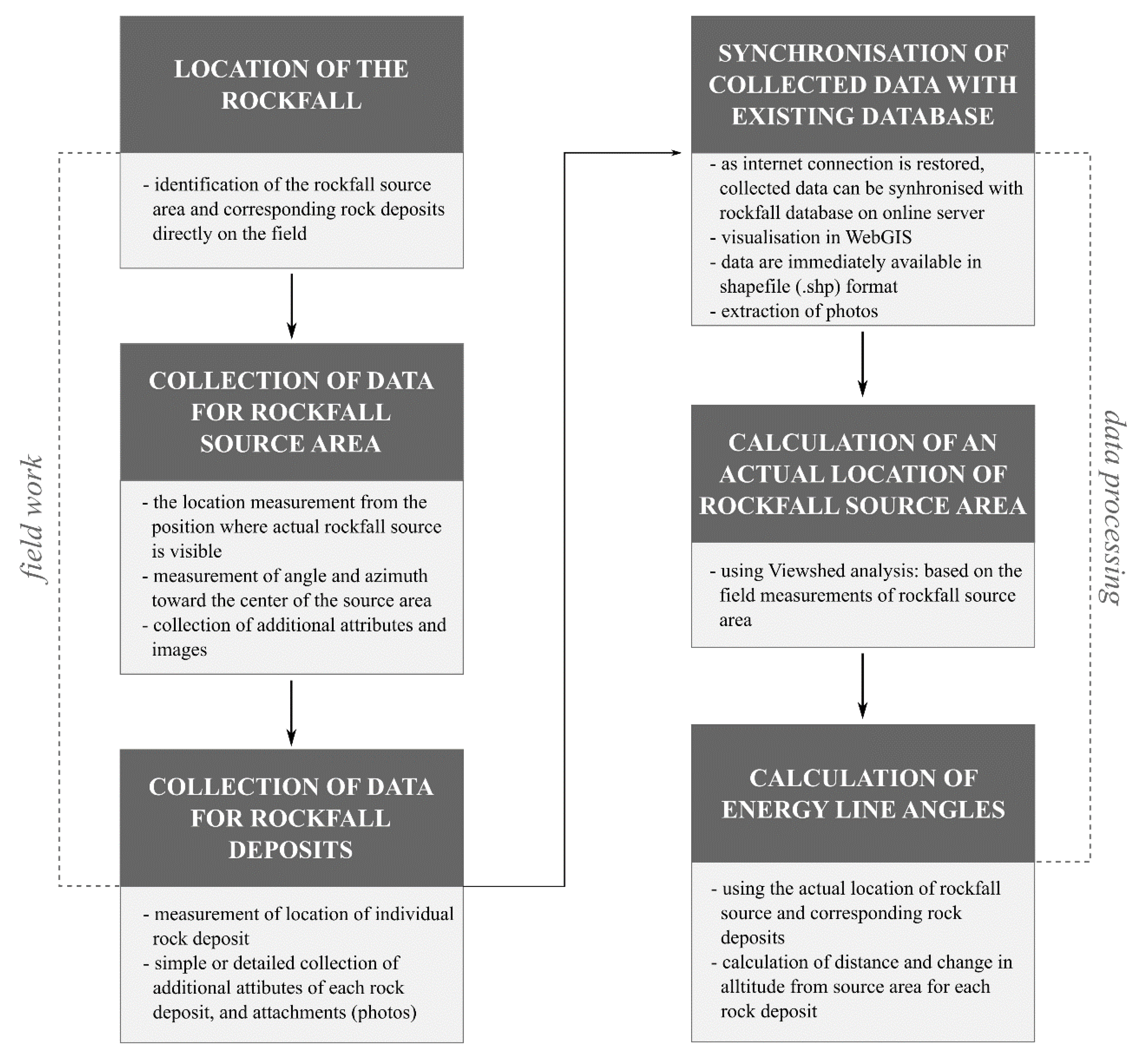
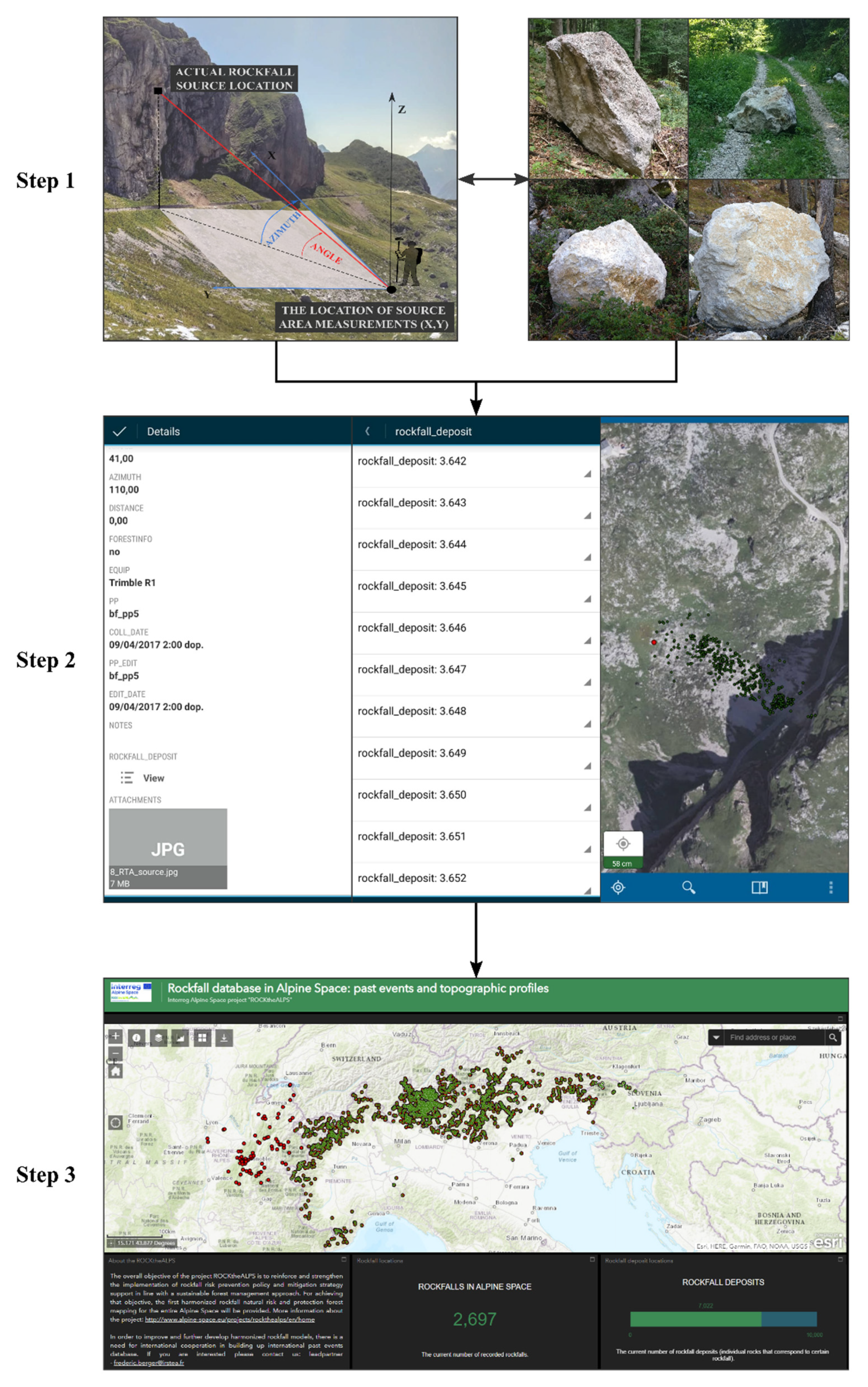
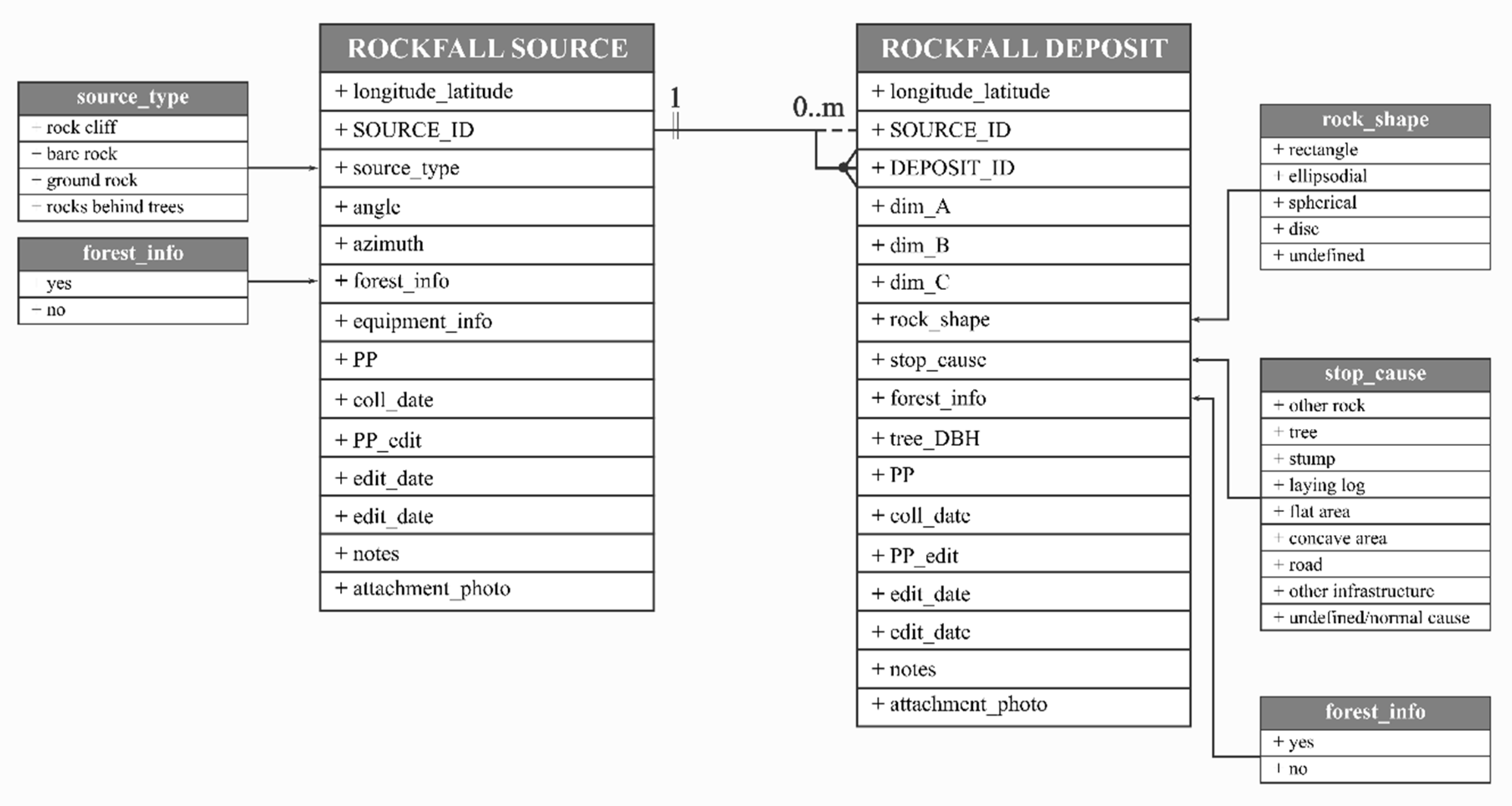
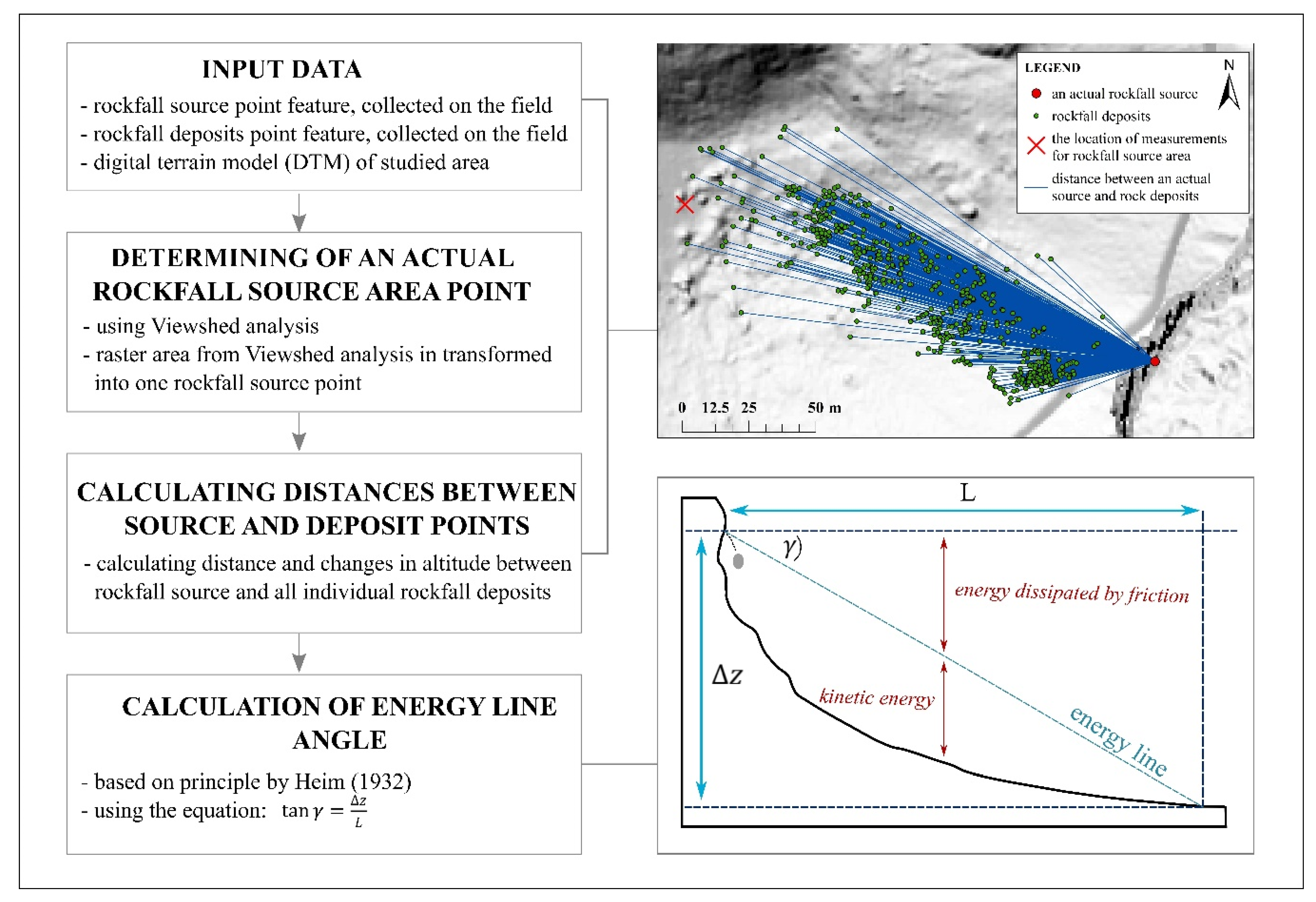
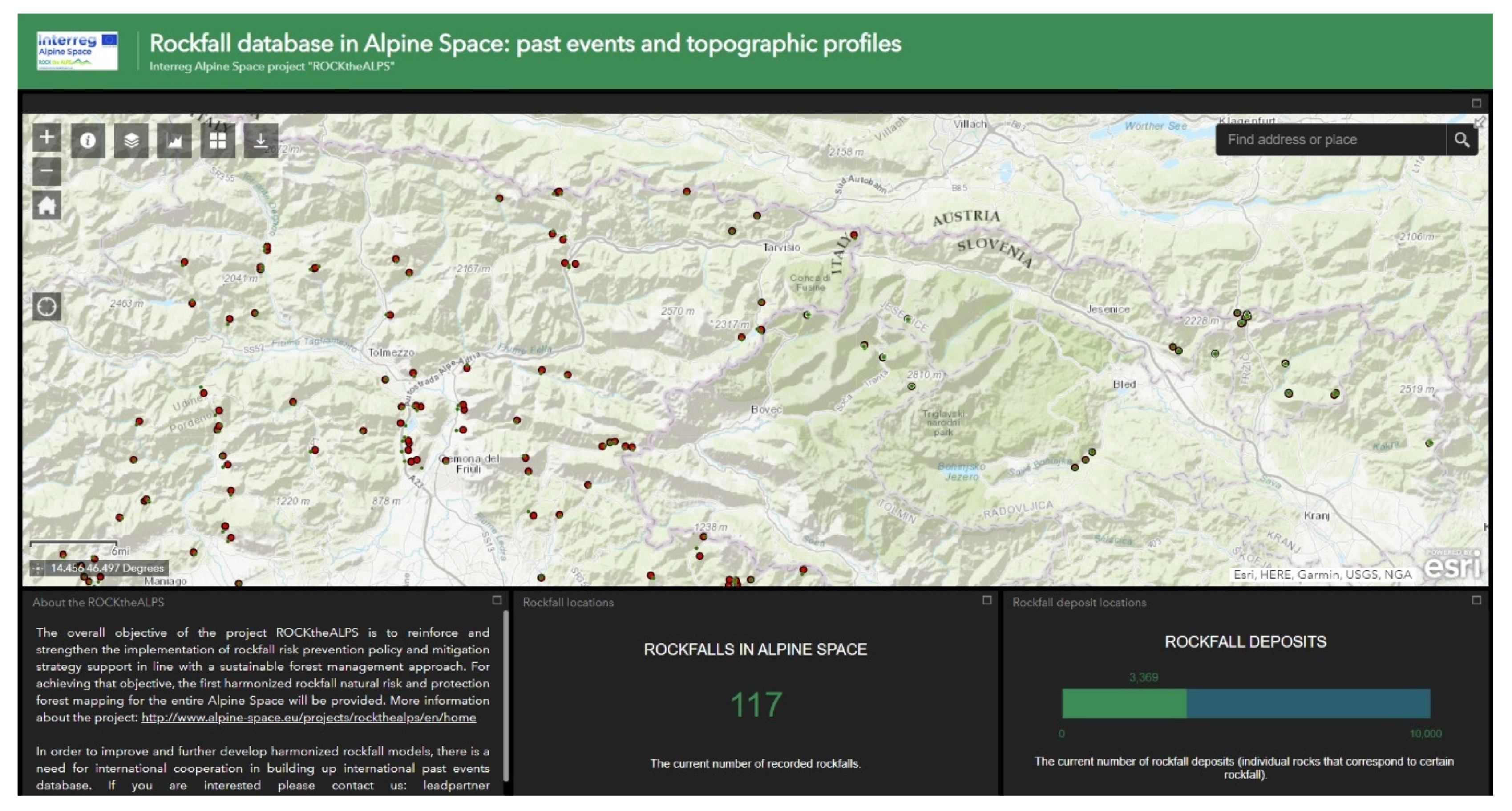
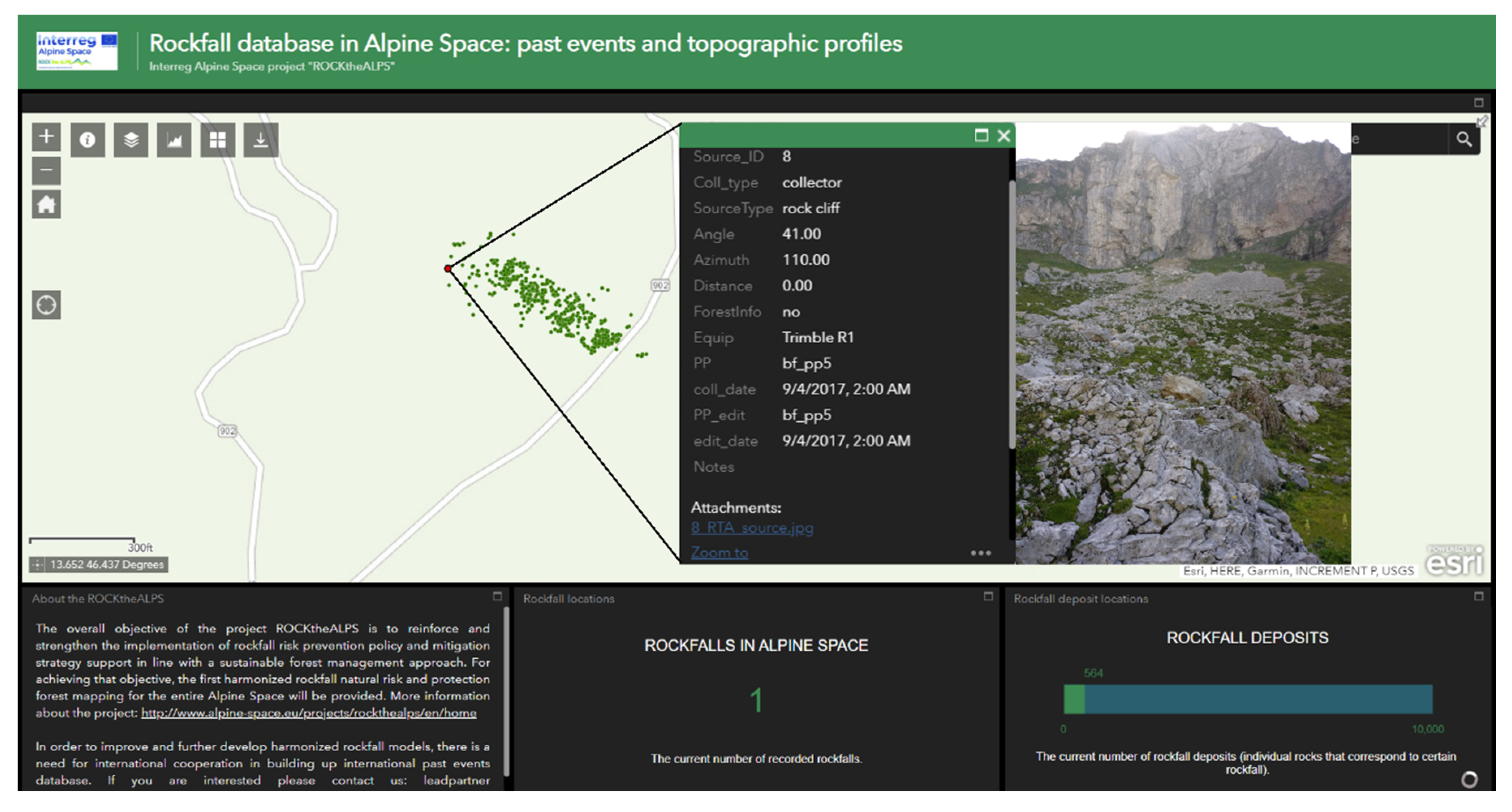
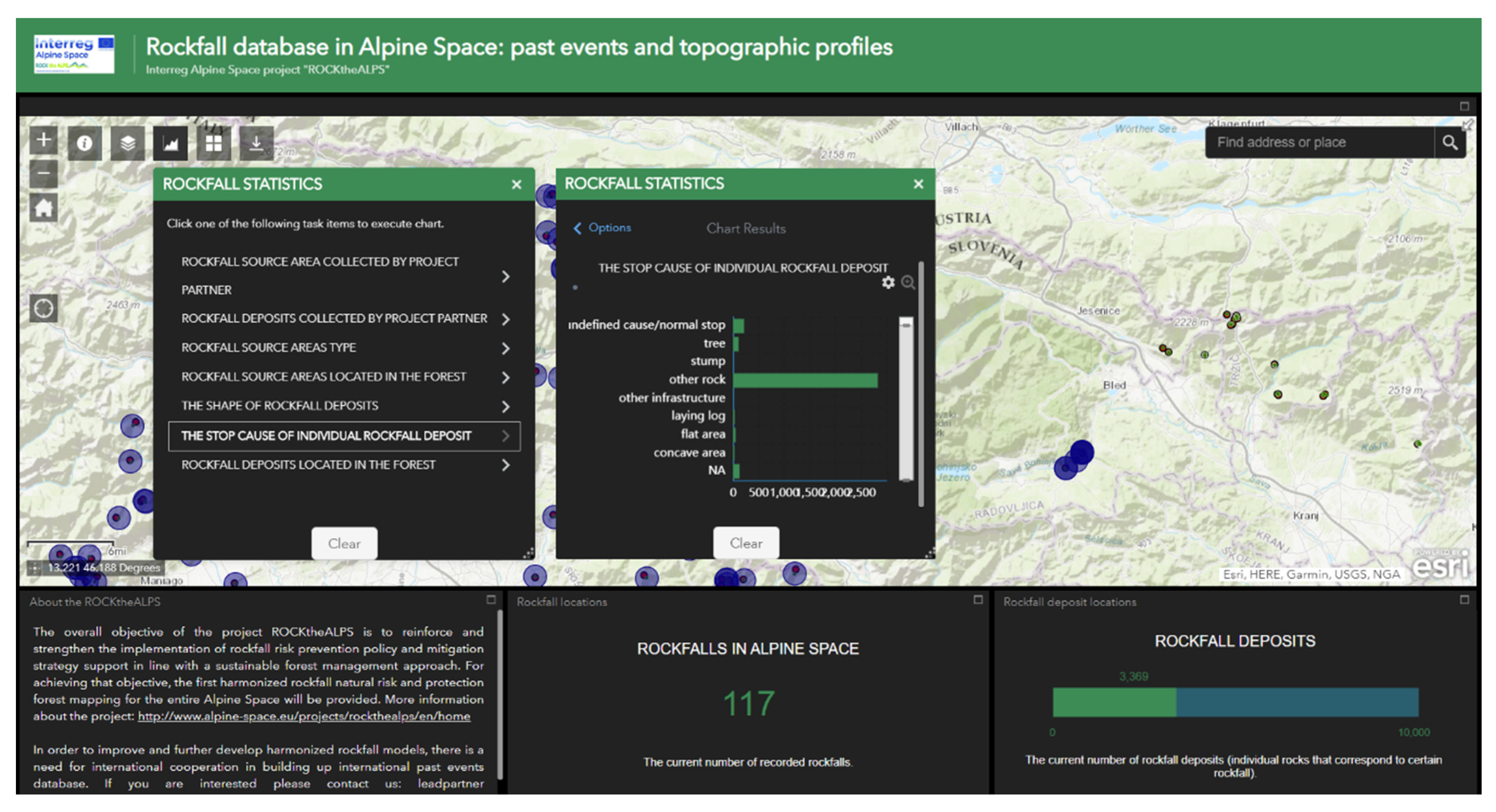
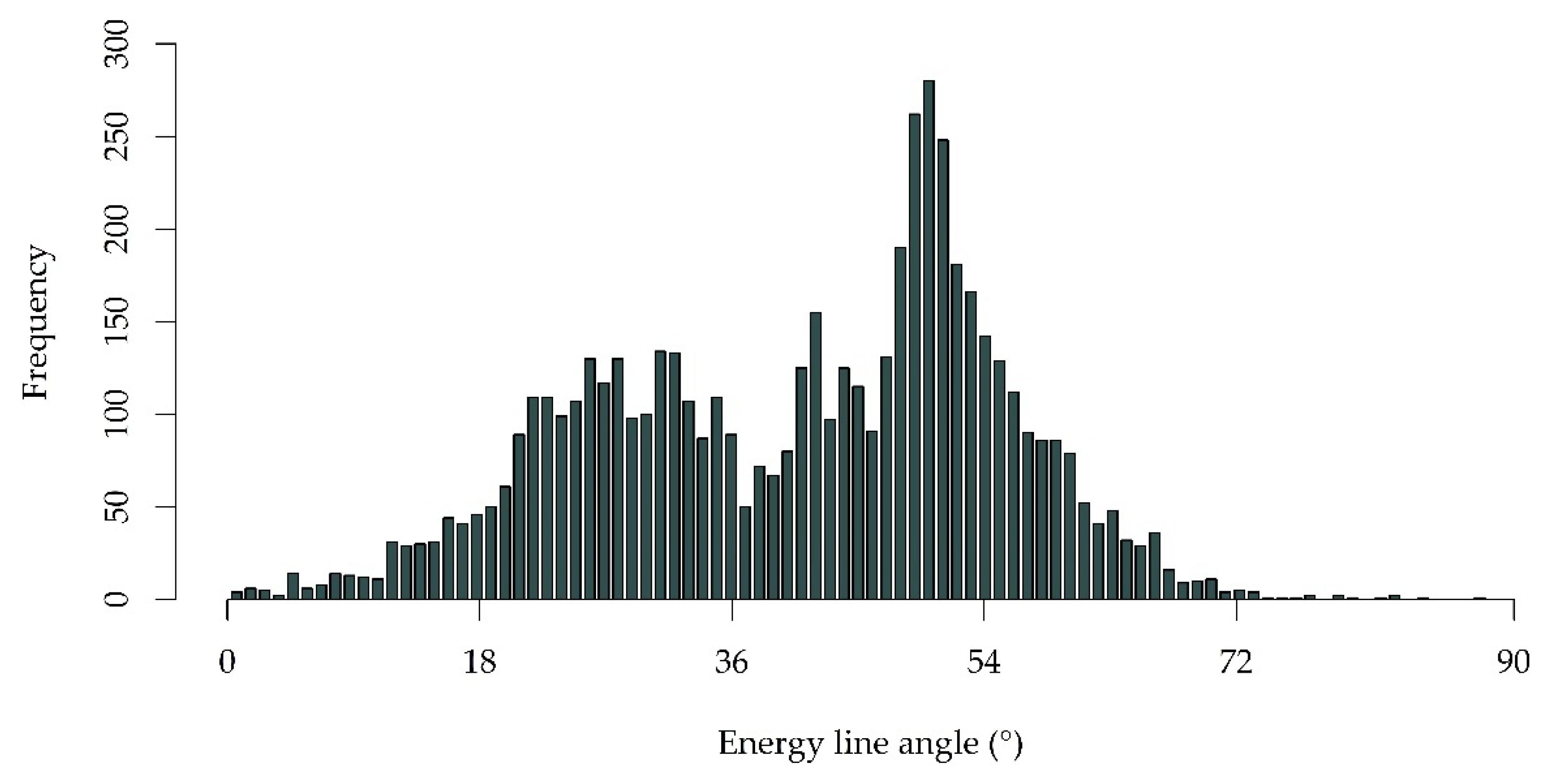
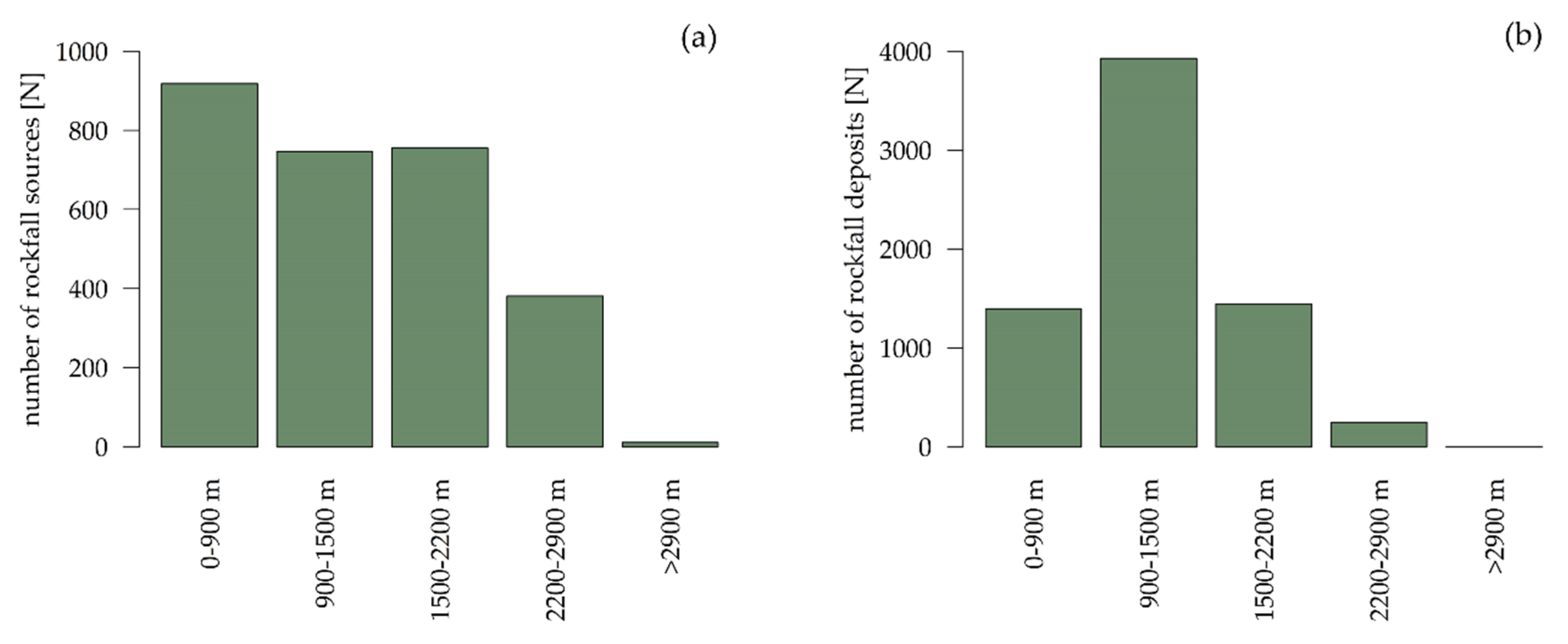
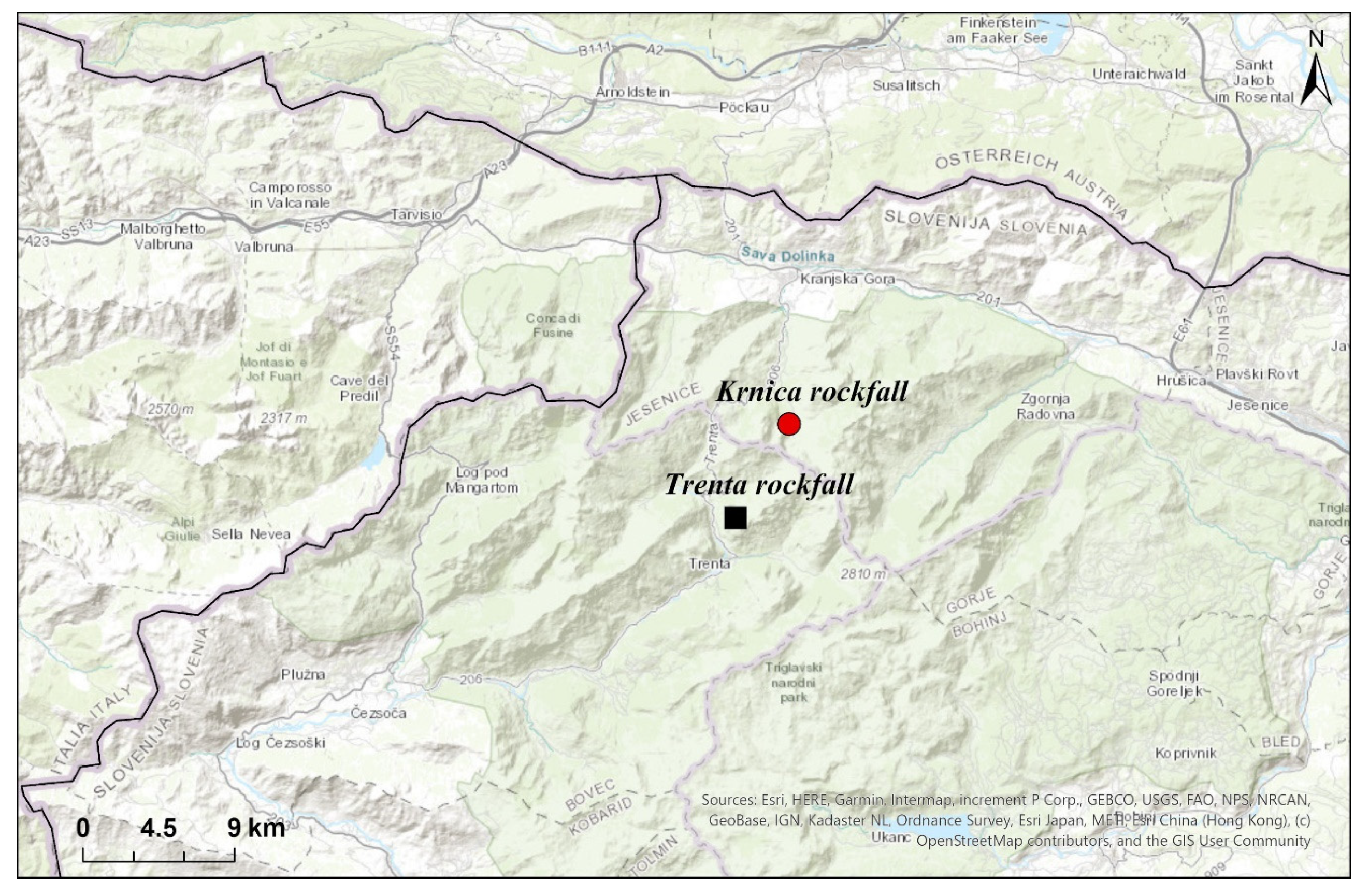
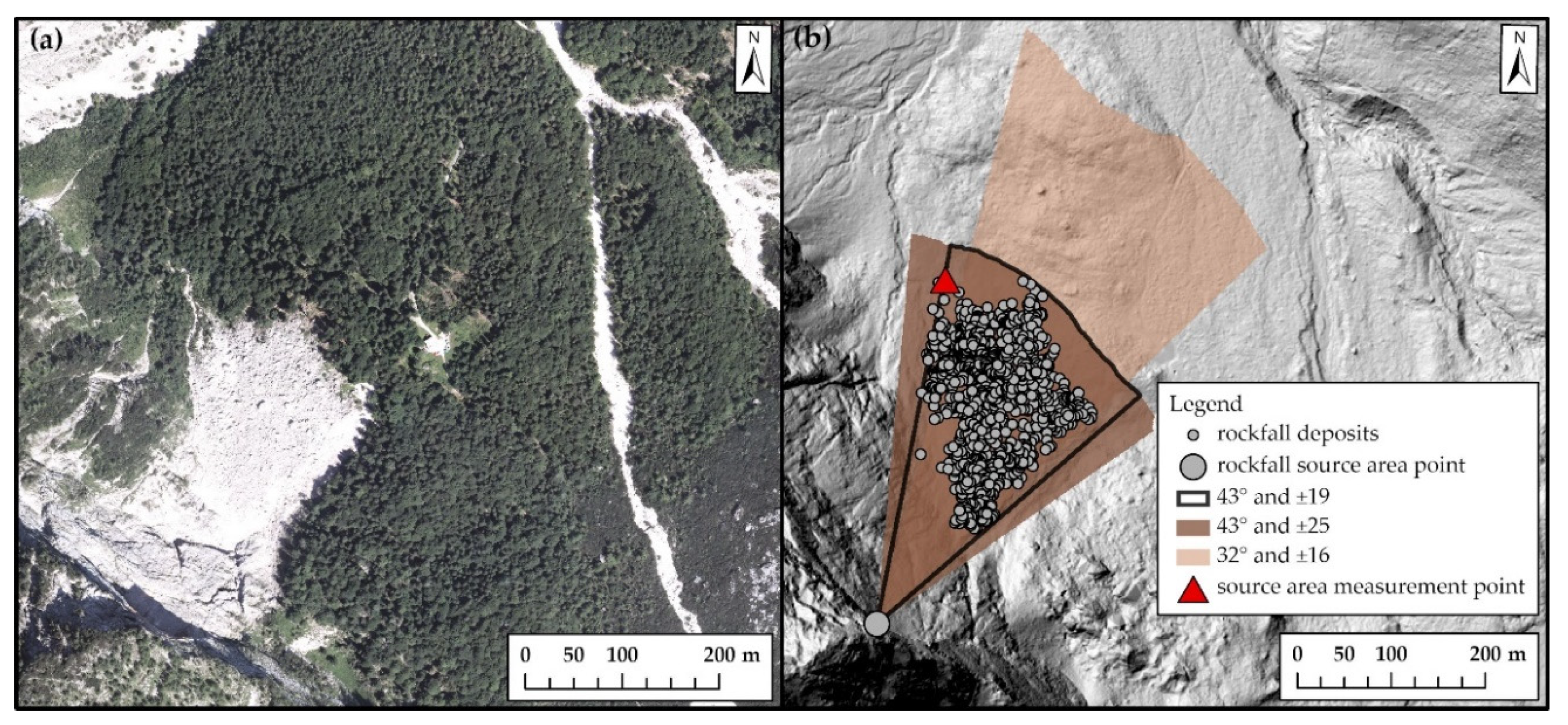
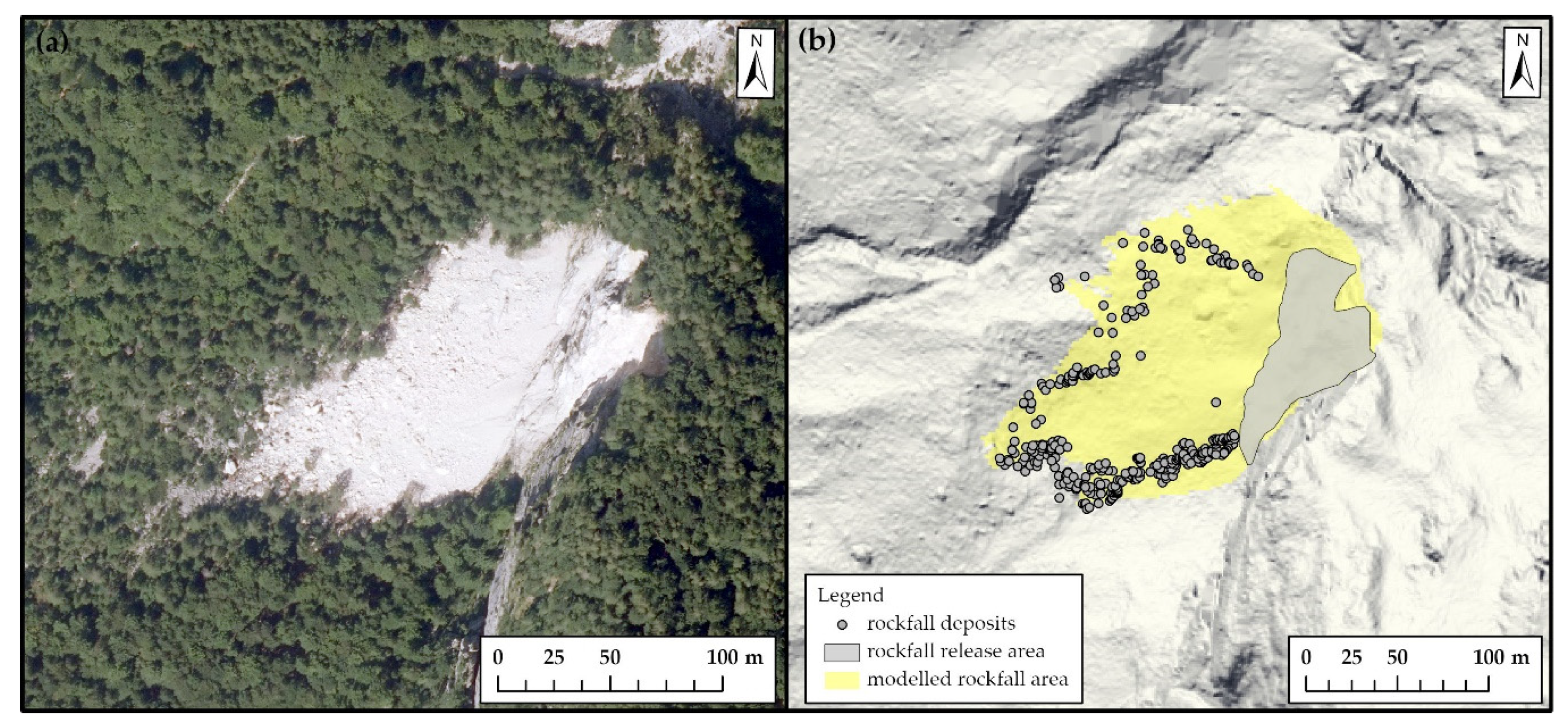
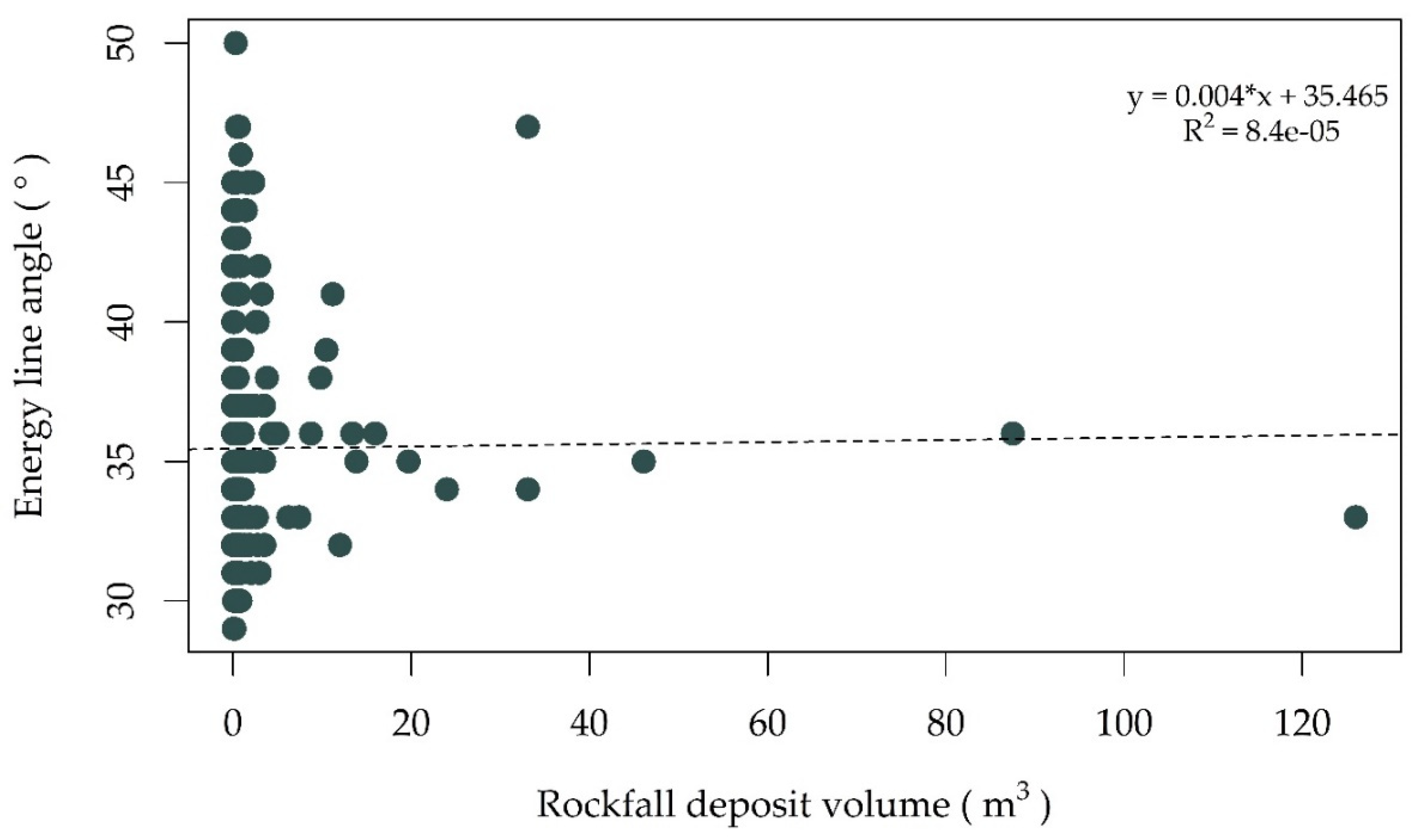
| (a) Rockfall Krnica energy line angle, lateral angle | Average Index (AI) | Success Index (SI) |
| 32°, ±16 | 0.78 | 0.89 |
| 43°, ±19 | 0.92 | 0.98 |
| 43°, ±25 | 0.88 | 0.97 |
| (b) Rockfall Trenta | 0.90 | 0.93 |
© 2020 by the authors. Licensee MDPI, Basel, Switzerland. This article is an open access article distributed under the terms and conditions of the Creative Commons Attribution (CC BY) license (http://creativecommons.org/licenses/by/4.0/).
Share and Cite
Žabota, B.; Kobal, M. A New Methodology for Mapping Past Rockfall Events: From Mobile Crowdsourcing to Rockfall Simulation Validation. ISPRS Int. J. Geo-Inf. 2020, 9, 514. https://doi.org/10.3390/ijgi9090514
Žabota B, Kobal M. A New Methodology for Mapping Past Rockfall Events: From Mobile Crowdsourcing to Rockfall Simulation Validation. ISPRS International Journal of Geo-Information. 2020; 9(9):514. https://doi.org/10.3390/ijgi9090514
Chicago/Turabian StyleŽabota, Barbara, and Milan Kobal. 2020. "A New Methodology for Mapping Past Rockfall Events: From Mobile Crowdsourcing to Rockfall Simulation Validation" ISPRS International Journal of Geo-Information 9, no. 9: 514. https://doi.org/10.3390/ijgi9090514
APA StyleŽabota, B., & Kobal, M. (2020). A New Methodology for Mapping Past Rockfall Events: From Mobile Crowdsourcing to Rockfall Simulation Validation. ISPRS International Journal of Geo-Information, 9(9), 514. https://doi.org/10.3390/ijgi9090514





